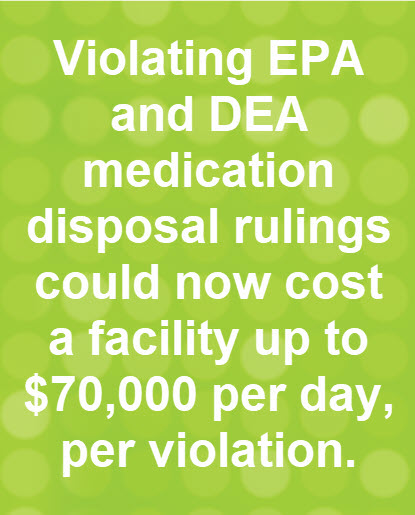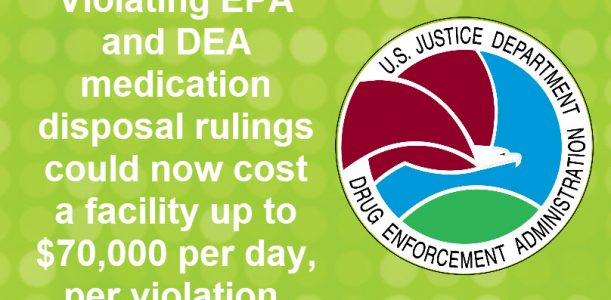
Can you imagine flushing chemotherapy drugs down the drain? Prior to the updated 40 CFR, drugs like chemotherapy drugs and opioids were regularly flushed as a permissible method of drug disposal. This in spite of mounting evidence of the damage this causes to the environment through contaminated soil and groundwater. Recent DEA and EPA regulations have changed all of that and healthcare facilities are expected to immediately get up to speed or pay hefty fines.
Many states have adopted the federal regulations on drug disposal entirely while other states have taken a more stringent approach. Healthcare systems that operate in multiple states will have to navigate a patchwork of all federal and state laws. While these medication disposal regulations may be long overdue, it is a huge undertaking for many hospitals especially those that operate multiple facilities in multiple states.
Penalties for Non-Compliant DEA Medication Disposal
Organizations may be hit with a variety of penalties if found in violation of updated DEA and EPA regulations such as flushing pharmaceuticals or not collecting and removing medication waste appropriately and at the right times. Penalties and fines have more than doubled in some cases since the expansion of the rules. Violating the rules listed in the RCRA could have been a fine of up to $37,500 per day under the previous rulings. Violating EPA and DEA medication disposal rulings could now cost a facility up to $70,000 per day, per violation. This could cause serious problems for any healthcare organization.
Violations under the Safe Water Drinking Act could now reach up to $60,000 per violation, where similar penalties previously were $35,000 for each day of violations. The burden is on the facility to train and monitor their staff to avoid significant fines.
Benefits of Compliance Drug Disposal
The benefits of compliant drug disposal is clear, safer disposal practices protect the environment and help to prevent drug diversion. Another benefit that facility managers appreciate is the streamlining of what were previously conflicting regulations for medication disposal from the DEA, EPA and FDA along with the elimination of duplicate reporting requirements. Maintaining compliance does not have to be difficult with the proper guidance on the new federal regulations.
C2R Global Manufacturing, Inc. Provides DEA Medication Disposal Compliance
C2R Global Manufacturing, Inc. supports customers to meet Drug Enforcement Administration (DEA) and Environmental Protection Agency (EPA) guidelines including 21 CFR and 40 CFR compliance. We make compliance as easy as 1-2-3 with simple disposal containers and our patented*, charcoal based formula. Just drop in the medication waste and Rx Destroyer™ will begin to instantly neutralize pharmaceutical waste and render it non-retrievable.
C2R Global Manufacturing, Inc. products are pharmacist approved and recommended, meeting cost, safety and efficacy considerations. We are dedicated to a simple yet profound fundamental goal to save water, save lives, one prescription at a time. Contact us to maintain compliance with EPA and DEA medication disposal compliance to prevent costly violations.

